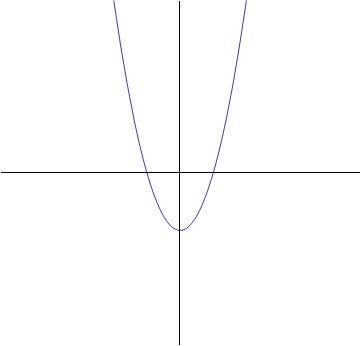All Algebra 1 Resources
Example Questions
Example Question #21 : Graphing
Which of the following is the graph of the equation 






On the coordinate plane, the graph of an equation of the form 





Example Question #22 : Graphing
Which of the following is the graph of the equation 




None of the other choices are correct.
None of the other choices are correct.
Since the intercepts are shown on each graph, we find the intercepts of 

Set
The graph goes through 
Example Question #23 : Graphing
Which of the following graphs best represents the following function?



None of these


This equation describes a straight line with a slope of 

The graph below is the answer, as it depicts a straight line with a positive slope and a negative y-intercept.

Example Question #24 : Graphing
Which of the following choices is an accurate visual description of the graph of
A line with a positive slope that crosses the 
A line with a slope of 

A parabola with its vertex at
A line with a negative slope that crosses the 
A line with a slope of zero that crosses the 
A line with a negative slope that crosses the 
Though this is a question about a graph, we don't actually have to graph this equation to get a visual idea of its behavior. We just need to put it into slope-intercept form. First, we subtract 
Simplified, this equation becomes
Remember, this is in 





Example Question #25 : Graphing
Which of the following is the graph of the equation 


None of the other choices are correct.



Since the intercepts are shown on each graph, we need to find the intercepts of 
To find the 


Therefore the 

To find the 


Thus the 

The correct choice is the line that passes through these two points.
Example Question #7 : How To Graph A Line
Which equation matches the graph of the line shown?

An equation of a line is made of two parts: a slope and a y-intercept.
The y-intercept is where the function crosses the y-axis which in this problem it is 0.
The slope is determined by the rise of the function over the run which is 
Therefore your equation is:

Example Question #1 : How To Graph A Point
Which image depicts the point 





The first number, 
Example Question #1 : How To Graph A Point
The length of line segment 

To answer this question, we will have to manipulate the distance formula:
To get rid of the square root, we can square both sides:
and plug in the information given in the question.
At this point we can simply plug in the possible values to determine which combination of coordinates will make the equation above true.
Thus the correct coordinate is,

Example Question #3 : How To Graph A Point

Graph the following 4 points. They will be displayed as (x,y) pairs.
(A)
(B)
(C)
(D)





To graph these points we just need to remember that the first number is the x value and the second number is the y value. For (A) we have (1,3). So we move one tick over on the positive x-axis. Then from there we move up to the third tick on the y axis:

If the value is negative we must move in the other direction. So, for all 4 points,

Example Question #4 : How To Graph A Point
What are the coordinates of the point on the given graph?

When trying to determine coordinates of a point you need to look at the value of x first (how many units left or right the point is, then the y-value (how many up or down it is).
When you look at this point you see that it is moved right 2 units and up 1.
So your coordinates are:
Certified Tutor
Certified Tutor
All Algebra 1 Resources















































